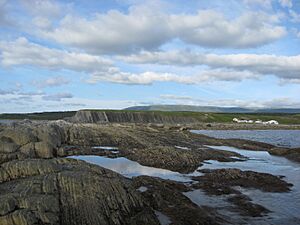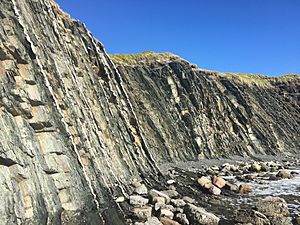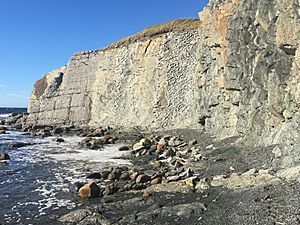Green Point, Newfoundland and Labrador facts for kids
Green Point is a cool spot found about 12 kilometers north of Rocky Harbour town. It's in Gros Morne National Park, on the west coast of Newfoundland. This place is home to a small fishing village in the summer and has a campground for visitors.
In 2000, Green Point became super important! It was chosen as a Global Stratotype Section and Point. This means it's a special place that shows exactly where one huge time period in Earth's history ends and another begins. Here, you can see the boundary between the Cambrian and Ordovician periods. These are two very old time periods when life on Earth was just starting to get complex.
Contents
Earth's Ancient Story at Green Point
The cliffs at Green Point are like an open book about Earth's past. In 2000, scientists from the International Union of Geological Sciences officially recognized these cliffs. They show the exact start of the Ordovician period.
Layers of Time
The boundary is a section of rock about 60 meters thick. It's made of layers of shale and limestone. These layers are tilted quite a bit, leaning 60-70 degrees to the southeast.
Fossils Marking the Spot
The official start of the Ordovician period at Green Point is marked by the first appearance of a tiny fossil creature called Iapetognathus fluctivagus. This creature was a type of conodont, which was a small, eel-like animal that lived in the ancient oceans. This important fossil is found 4.8 meters below the oldest known Rhabdinopora praeparabola fossil. This second fossil is a type of graptolite, which were tiny sea animals that often floated in colonies.
Deep Ocean Sediments
The shale layers you see at Green Point tell a story that spans 30 million years! They are made from deep-ocean mud that settled at the bottom of the ancient Iapetus Ocean. This ocean existed long, long ago. The limestone layers in between the shale show that there were also occasional rock slides from shallower parts of the ocean. These rock slides carried material down to the deeper parts. You can even see parts of these same limestone slides further up the coast at a place called Cow Head. The rocks in the limestone conglomerate there are much bigger!
Campground Fun
If you want to stay and explore Green Point, there's a campground right there! It has 31 spots where you can drive in and set up your camp. It's a great place to stay while you explore Gros Morne National Park and learn more about Earth's amazing history.




